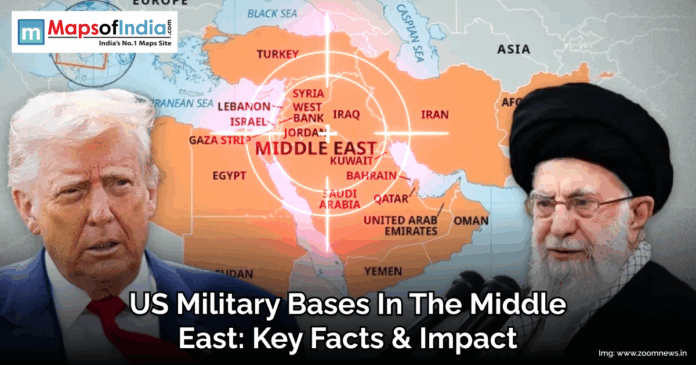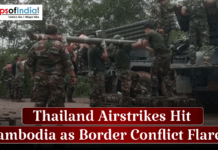The US has a military presence in the Middle East, which has, over the years, been regarded as one of the most geopolitically sensitive and unstable regions in the world. The presence has elicited discussions on the issue of security and sovereignty, diplomacy and imperialism. They are American bases in Saudi Arabian deserts, the waters of the Persian Gulf: logistics centres, outposts of enemies, and maintainers of power in the region.
As discussed in this blog, the US has bases at various locations across the Middle East, but what is the history behind these bases, the strategic rationale, and geographical distribution thereof, as well as the controversies surrounding these bases and their implications all of which we have given a discussion in this blog.
Historical Background: Why the US Came to the Middle East
The origins of the US military in the Middle East could be traced to the events of World War II when the US and its allies relied on the oil fields and altitude of the region due to the strategic value of its air routes. Once the war was over, the advent of the Cold War with the Soviet Union gave the US even more incentive to set up closer relations and US bases in the Gulf and elsewhere.
The Gulf War in the year 1990 represented a new landmark. Following the invasion of Kuwait by Iraq, the US committed hundreds of thousands of their soldiers to Saudi Arabia and other allies in the region. Many of them left at the end of the war, however, and some were left to disperse ongoing aggression and guarantee supply of oil markets.
Key US Military Bases in the Middle East
1. Al Udeid Air Base – Qatar
Al Udeid is the biggest American military base in the Middle East, and it is found south west of Doha. It is the forward headquarters of US Central Command (CENTCOM) and US Air Forces Central Command (AFCENT), and with more than 10,000 US personnel it constitutes the largest overseas US military base.
It contains high-level fighter aircraft, surveillance avia, and demanding command facilities. Al Udeid has featured in Iraq, Afghanistan and Syria.
2. Camp Arifjan – Kuwait
Camp Arifjan is an important logistics and support hub of the US (military) operations. It is a transit camp of personnel and equipment going in and out of the fighting areas of the region.
Having more than 9,000 US forces, this base is very instrumental towards the mobility in the region and its quick responsiveness.
3. Ali Al Salem Air Base – Kuwait
Referred to as the Gateway to the Desert, Ali Al Salem facilitates air surveillance and rationalization functions and airlift operations. Several missions were used in the Iraq War within the base, and are still in use to operate throughout the Gulf.
4. Prince Sultan Air Base – Saudi Arabia
After holding this base following the Iraq War until domestic political pressure forced them to withdraw, they reopened this base in 2019 during increased tensions with Iran. The US subsequently took positions by shipping its defenses through Patriot missile launchers and F-15 fighter jets to cover Saudi airspace against the Houthi rebels.
5. Naval Support Activity – Bahrain
This base is in Manama, Bahrain which fortifies the Bahrain headquarters of the Fifth Fleet of the US Navy. It is vital to Maritime security of the Persian Gulf, Red Sea, Arabian Sea and portions of the Indian Ocean.
The base assists with naval activities, anti piracy/freedom of navigation patrols, particularly through the Strait of Hormuz the key point choke pipe to oil.
6. Al Dhafra Air Base – United Arab Emirates
Placed on the territory of Al Dhafra, where a large number of people of the US Air Force will be stationed, F-35s, drones, and the recon house aircraft will be equipped. It is instrumental in the intelligence, surveillance and reconnaissance (ISR) of the Middle East and Africa.
7. Tanf Garrison – Syria
This base was built in the southeast of Syria close to the Iraq and Jordan borders to be a part of the US-led campaign against ISIS. It has been strategically located to break Iranian land networks and track the movements of the militia but its legal position has been disputed as it is located in a nation where the US has no major contracts.
8. Erbil and Al-Asad Airbases – Iraq
The US still has a large footprint in Iraq with such functional bases as Al-Asad in Anbar Province and Erbil in the Kurdish region. Although fighting troops are minimized, such bases are used to train, give advice, and fight ISIS there.
9. Muwaffaq Salti Air Base – Jordan
Muwaffaq Salti Air Base is a strategic facility in the US and coalition operations against ISIS and other extremist organizations in the East of Jordan, far away only a few kilometers to the town of Azraq. The base facilitates flights done by drones and fighter jets and is strategically located because it is near Syria and Iraq. Jordan maintains a close military relationship with the US and such a base is indispensable in the transfer of intelligence, training and rapid reaction of the US in case of a regional conflict or attack.
Strategic Purposes of US Bases in the Region
The existence of the American military bases in the Middle East has little to do with war, but connotes a variety of geopolitical interests:
- Counterterrorism: Drones attacks, special forces, and intelligence activities that fight terror groups, such as ISIS, Al-Qaeda, or their affiliates, find a base to operate on.
- Deterring Iran: Most of the bases are under a reckoning plan of keeping Iranian power in Iraq, Syria, Lebanon, and Yemen at bay.
- Energy Security: The ability to maintain the free flow of oil and gas across the Gulf is an historical priority to the US. Bases are useful to ensure shipping routes and choke points (such as the Strait of Hormuz) are guarded.
- Alliance Assurance: US bases help in the defense relationship between the US and the gulf monarchies, Israel and Jordan by offering them extended deterrence and training of operations.
- Power Projection: The Ability to quickly deploy out of these bases would enable the US to counter arising threats or crises in East Africa through Central Asia.
Impact on Regional Politics
The trace of the American military influence alters local politics in several manners:
- Strengthening Monarchies: Hosting of US forces gives other countries such as Bahrain, UAE and Saudi Arabia some military advantage and legitimacy within their own borders.
- Military Aid and Arms Sales: US installations are likely to bring more defense collaboration such as very big arms packages, such as the F-35s to the UAE and the Patriot missiles to Saudi Arabia.
- Proxy Conflicts: The emergence of proxy wars is possible when the US occupation is involved, especially proxy war between the US-backed troops and Iran-supported militants in Iraq, Syria and Yemen.
The Way Forward: Is Retrenchment Possible?
Over the recent years, there has been the rising voice of re-examination of the American military presence in the US and the Middle East. This exists alongside the withdrawal of Afghanistan in 2021, and it questions the viability of long-term foreign deployments. Nevertheless, due to such threats as terrorism, regional instability, increased Chinese and Russian hegemony, it does not appear that total disengagement is in store.
Possibly to minimize the reverse impact on host nations, as well as expense, some scholars promote what they call lily pad strategies, miniaturized, lighter, more rapid deployment platforms instead of grandiose permanent installations.
Conclusion
The complex nature of US military bases in the Middle East can be ascribed to national security, diplomacy as well as influence. As beneficial as they are strategically, they are also risky, exposing the country to the dangers of entanglement and to regional friction and to fraudulently. After the world shifts in its global movements, the US has to maintain a fine balance of presence and overstretch, involvement and disengagement.
More intelligent, diplomatic, and regionally sensitive military posture can be the only prospect of the long lasting peace and stability long needed in the Middle East and American interests as well.




